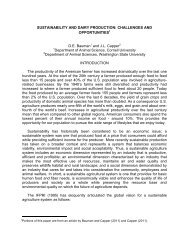1 GOAT SEMEN COLLECTION AND PROCESSING BY DR. LOUIS ...
1 GOAT SEMEN COLLECTION AND PROCESSING BY DR. LOUIS ...
1 GOAT SEMEN COLLECTION AND PROCESSING BY DR. LOUIS ...
You also want an ePaper? Increase the reach of your titles
YUMPU automatically turns print PDFs into web optimized ePapers that Google loves.
The resorption of sperm is weak in the epididymis with most loss occurring in the urine or by<br />
masturbation. The epididymal sperm reserves available daily for ejaculation are readily depleted<br />
with approximately 62% of the potential daily sperm collection being obtained in the first two<br />
ejaculates. Epididymal replenishment is fairly rapid and collections twice per day at 24 hr intervals<br />
have been practiced in well-managed facilities. In adult Alpine males ejaculated once per day during<br />
the breeding season, weekly production of up to 25 billion spermatozoa per animal have been<br />
attained.<br />
Even with our ability to supposedly package enough viable and morphologically normal cells<br />
in a straw or ampule, there remains factors of semen that contribute to fertility (or lack thereof) that<br />
are not well understood. It has been found in many bull studs that bulls with high semen quality<br />
credentials give lower than desirable fertility. Conversely, some ejaculations of "apparent" poor<br />
visual quality readily settle animals. These unknowns might range from subtle differences in the<br />
DNA makeup to handling and inseminating interacting with the semen available. Recent<br />
development of tests to evaluate the integrity of the internal nucleic acid component may shed light<br />
on fertility availability.<br />
Subjective evaluation of semen has been the one method commonly used out of necessity,<br />
because no other alternatives were available. Unfortunately, this approach is often prone to observer<br />
bias and error. To eliminate this bias, a number of computerized semen analyzers have recently been<br />
introduced onto the market. Any system of this type must rely on image size, shape, and/or grey<br />
scale characteristics to distinguish individual spermatozoa and differentiate them from debris that<br />
may be present in the field of view. Such discrimination is not 100% accurate. Even if a system<br />
were very accurate and precise in its tracking and detection, the objective data obtained might not be<br />
10

















